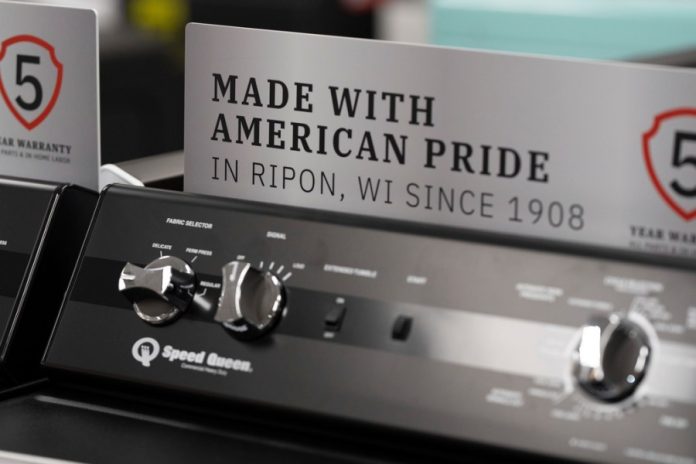
The checkout line is where American dreams crash into American paychecks. Beneath the sterile glare of fluorescent lights, surrounded by shelves stacked with promises, ordinary Americans reach not for what they want, but for what they can afford.
And they do it again and again and again.
The woman ahead of you examines two identical-looking coffee makers. One bears a small “Made in USA” sticker and costs $89. The other, manufactured somewhere in Asia — most likely China — rings up at $29. She holds the American-made model for a moment, reading the label twice. Then she sets it back on the shelf and takes the cheaper one. Her face says it all. What looks like apathy toward American jobs is nothing but cold, merciless math — the difference between putting dinner on the table and making excuses to the kids.
No wonder support for “Made in America” has fallen from 60 percent to 50 percent in just two years. That 10-point drop is more than a shifting consumer taste; it’s a national ideal smashing up against everyday reality. For generations, the phrase carried real weight. It was pride forged into steel, stitched into seams, etched into every surface. Then it slipped.
“Made in America” stopped standing for quality and started standing for cost. Corporations learned they could slash expenses by shipping jobs overseas while keeping profits bloated. Consumers got cheaper goods, shareholders pocketed richer dividends, and American workers got pink slips. Still, the romance lingered.
Americans haven’t stopped loving the idea of supporting domestic manufacturing. They’ve simply run out of cash to afford their patriotism. The average American has barely anything in savings. Tens of millions of citizens can’t cover a $1,000 emergency without incurring new debt, and yet they are told to spend $3,000 on a “Made in America” iPhone. That tension feeds straight into politics.
The political divide over “Made in America” reveals an economic reality that runs deeper than partisanship. Sixty-six percent of Republicans say they prefer domestic products compared to 42 percent of Democrats. Tragically, the voters shouting loudest for “Made in America” are the very ones priced out of it. Working-class families who wave the flag for domestic industry still stock up at Walmart, Dollar General and Amazon — not out of disloyalty, but out of a need for basic survival. Their shopping carts don’t betray their values — they betray the brutal reality of living paycheck to paycheck.
They love the idea of buying American, and why wouldn’t they? Their parents and grandparents did precisely that — cars, appliances, tools, clothes. A Maytag washer ran for 20 years. A Ford pickup lasted for decades if you looked after it. “Made in America” once meant durability and quality. Back then, nobody wanted “Made in China” because America’s output was so superior —stronger steel, better engineering, standards that spoke for themselves.
But those days are long gone, and tariffs won’t bring them back. Slapping taxes on imports doesn’t revive craftsmanship; it just punishes families already on the edge. The single mother still can’t buy the American-made winter coat. The only change is that the Chinese version now costs $40 instead of $35.
Real solutions would dig into why American manufacturing lost its edge, and how to restore value, not just raise prices. That means cutting through the regulatory maze that adds thousands of dollars to production costs. It means rewriting a tax code that rewards companies for moving operations offshore. It means reviving vocational education, so the trades that built the country aren’t abandoned in favor of paper degrees for jobs that don’t exist.
Most fundamentally, it would acknowledge that Americans can’t buy American-made goods unless they earn American-level wages. You can’t rebuild factories while workers scrape by on service pay. You can’t revive industrial towns when their residents rely on food stamps and part-time retail jobs. Without wages that can support a family, “Made in America” is just a label on products nobody can buy.
The tragedy isn’t that Americans choose foreign goods over domestic ones. It’s that they’ve been forced into a position where supporting their own economy requires sacrificing their family’s welfare — where patriotism becomes a luxury and loving your country means choosing between heating bills and American-made shoes.
Walk down the empty Main Streets of Pennsylvania or Ohio, and you’ll see the truth written on every storefront. Boarded-up factories, once proud employers, now stand as monuments to offshoring. Families scrounge at dollar stores because everything else is out of reach. Young people leave for cities, not because they want to, but because there’s no work at home.
To make “Made in America” truly great again would mean more than empty promises or taxing imports. It will come only when American workers earn enough to buy what they build, when factories compete through excellence instead of protection, when patriotism and practicality finally pull in the same direction. Until then, Americans will keep facing that quiet heartbreak at the checkout counter. They will keep choosing their children over their country, because decent people, when forced into that cruel choice, always put love of family above love of flag.
The real question isn’t why Americans won’t buy American. It’s why America won’t pay Americans enough to afford American-made goods.
John Mac Ghlionn is a writer and researcher who explores culture, society and the impact of technology on daily life.

